“Global Translation Management Systems Market to reach a market value of USD 5.8 Billion by 2030 growing at a CAGR of 17.5%”
The Global Translation Management Systems Market size is expected to reach $5.8 billion by 2030, rising at a market growth of 17.5% CAGR during the forecast period.
Localization tools help businesses customize their content to resonate with local audiences. Therefore, the localization software segment captured $245.9 million revenue in the market in 2022. This includes adapting language, date formats, currencies, images, and cultural references to match the preferences and expectations of users in different regions.

The major strategies followed by the market participants are Partnerships, Collaborations & Agreements as the key developmental strategy to keep pace with the changing demands of end users. For instance, In December, 2023, Google LLC signed a partnership with Mistral AI. Through this partnership, Google would leverage its Cloud AI-optimized infrastructure, including TPU Accelerators, to advance the testing, development, and scalability of its LLMs. In October, 2023, SAP SE teamed up with Accenture PLC. Through this collaboration, both companies will develop AI-powered solutions and use cases designed to enhance the value of an organization's investment in SAP technology by boosting business performance and employee productivity, while also accelerating the time to value with SAP S/4HANA Cloud.
Based on the Analysis presented in the KBV Cardinal matrix; Microsoft Corporation and Google LLC (Alphabet Inc.) are the forerunners in the market. In October, 2023, Microsoft Corporation expanded its partnership with Siemens AG, a German multinational technology conglomerate, and introduced Siemens Industrial Copilot as a first step, an AI-powered assistant improving human-machine collaboration in manufacturing. The integration between Siemens Teamcenter software and Microsoft Teams was launched, simplifying virtual collaboration across business functions. Companies such as Amazon Web Services, Inc. (Amazon.com, Inc.), Oracle Corporation, SAP SE are some of the key innovators in the market.
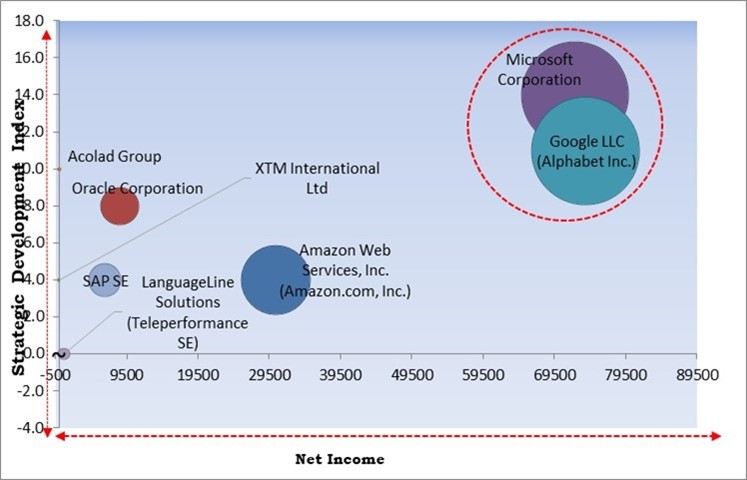
A significant surge in multilingualism has occurred across diverse forms of online content in the digital realm, primarily propelled by the expanding globalization of enterprises and the expanding variety of online audiences. As organizations broaden their international presence, there arises an increasing necessity to engage customers effectively through communication conducted in their native tongues. Therefore, these factors will aid the market's growth in the coming years.
The demand for real-time translation solutions has been steadily increasing, driven by the growing need for instant and seamless communication across languages in various sectors such as business, education, healthcare, and travel. Real-time translation tools, such as apps and devices, enable businesses to conduct meetings, negotiations, and conferences in multiple languages, enhancing collaboration and productivity. Hence, the increasing demand for real-time translation supports the demand for TMS.
While machine translation (MT) has made significant advancements in recent years, there are still limitations to its accuracy and reliability, especially for complex or specialized content. Organizations that rely heavily on high-quality translations may hesitate to adopt MT as part of their translation workflow, impacting the demand for TMS that integrate MT capabilities. Thus, all of the aforementioned factors may hamper the market's growth.
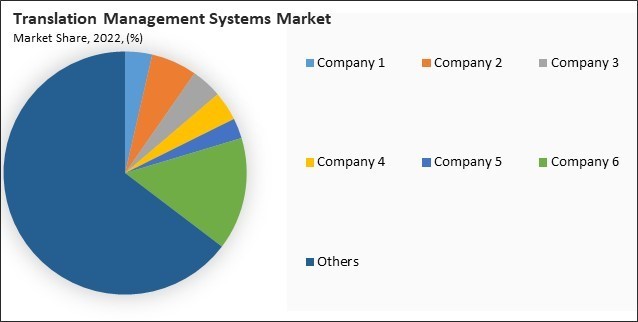
The leading players in the market are competing with diverse innovative offerings to remain competitive in the market. The above illustration shows the percentage of revenue shared by some of the leading companies in the market. The leading players of the market are adopting various strategies in order to cater demand coming from the different industries. The key developmental strategies in the market are Partnerships & Collaborations.
Based on offering, the market is characterized into software and services. The software segment garnered 74.3% revenue share in the market in 2022. TMS software is often more cost-effective for businesses, especially for those with frequent or large-scale translation needs. The software provides users with greater control over the translation process.
The software segment is further subdivided into translation software, localization software, translation project management software, terminology management software, quality assurance software, analytics & reporting, and others. The translation software segment procured 29.9% revenue share in the market in 2022. With the globalization of businesses, there is a growing need to communicate with customers, partners, and employees in multiple languages.
On the basis of content type, the market is classified into audio-based content, video-based content, and text-based content. The audio-based content segment procured 34.0% growth rate in the market in 2022. The expansion of audio-based content is driven by its convenience, accessibility, and the proliferation of audio-enabled devices.
Based on business function, the market is segmented into legal, finance & accounting, sales & marketing, human resources, and others. The sales & marketing segment garnered 40.2% revenue share in the market in 2022. For the development of brand recognition and trust, it is vital to preserve brand consistency across markets and languages.
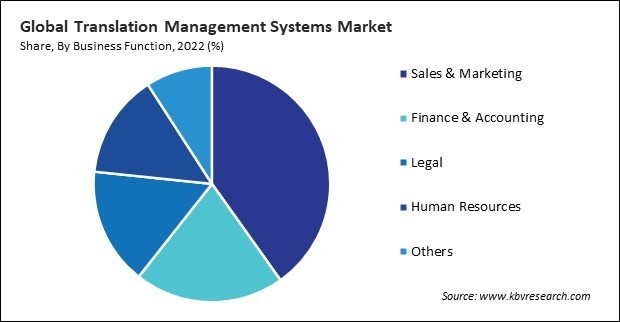
By application, the market is divided into translation, terminology management, quality assurance, project management, resource management, billing & invoicing analysis, and others. The project management segment recorded 12.1% revenue share in the market in 2022. In addition to task allocation, communication, and project configuration, TMS offers a centralized environment for overseeing every facet of translation projects.
On the basis of vertical, the market is divided into BFSI, healthcare & life sciences, transportation & logistics, manufacturing, retail & e-commerce, media & entertainment, education, IT & ITeS, and others. The BFSI segment garnered 23.9% revenue share in the market in 2022. Many BFSI companies are expanding their operations into new markets where different languages are spoken.
Free Valuable Insights: Global Translation Management Systems Market size to reach USD 5.8 Billion by 2030
Region-wise, the market is analysed across North America, Europe, Asia Pacific, and LAMEA. The Asia Pacific segment procured 26.9% revenue share in the market in 2022. The Asia Pacific region is increasingly connected to the global economy, with businesses and organizations operating across borders.
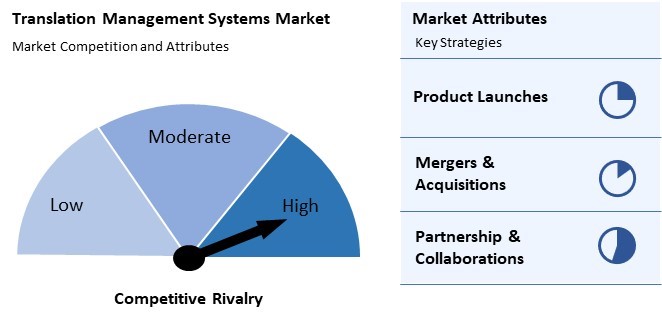
Competition in the market is intense, spurred by the globalization of businesses and the growing demand for localization services across various industries. Key players in this market range from established language service providers to tech giants offering cloud-based TMS solutions. Competition primarily revolves around features such as translation quality, automation capabilities, integration with other software systems, ease of use, and pricing models. Additionally, factors like support for multiple languages, AI-driven translation technologies, security features, and customer support play significant roles in shaping competition. As businesses increasingly prioritize localization to reach diverse markets, TMS providers are continuously innovating and expanding their offerings to gain a competitive edge in this rapidly evolving market landscape.
| Report Attribute | Details |
|---|---|
| Market size value in 2022 | USD 1.6 Billion |
| Market size forecast in 2030 | USD 5.8 Billion |
| Base Year | 2022 |
| Historical Period | 2019 to 2021 |
| Forecast Period | 2023 to 2030 |
| Revenue Growth Rate | CAGR of 17.5% from 2023 to 2030 |
| Number of Pages | 488 |
| Number of Tables | 773 |
| Report coverage | Market Trends, Revenue Estimation and Forecast, Segmentation Analysis, Regional and Country Breakdown, Market Share Analysis, Competitive Landscape, Porter’s 5 Forces Analysis, Company Profiling, Companies Strategic Developments, SWOT Analysis, Winning Imperatives |
| Segments covered | Offering, Content Type, Business Function, Application, Vertical, Region |
| Country scope |
|
| Companies Included | Microsoft Corporation, Google LLC (Alphabet Inc.), Amazon Web Services, Inc. (Amazon.com, Inc.), Oracle Corporation, SAP SE, Acolad Group, LanguageLine Solutions (Teleperformance SE), Babylon Software Ltd., XTM International Ltd, United Language Group Limited |
By Offering
By Content Type
By Business Function
By Application
By Vertical
By Geography
This Market size is expected to reach $5.8 billion by 2030.
Substantial rise in multilingualism across digital content are driving the Market in coming years, however, Concerns about the quality of machine translated texts restraints the growth of the Market.
Microsoft Corporation, Google LLC (Alphabet Inc.), Amazon Web Services, Inc. (Amazon.com, Inc.), Oracle Corporation, SAP SE, Acolad Group, LanguageLine Solutions (Teleperformance SE), Babylon Software Ltd., XTM International Ltd, United Language Group Limited
The expected CAGR of this Market is 17.5% from 2023 to 2030.
The Translation segment is generating highest revenue in the Market by Application in 2022; there by, achieving a market value of $2.0 billion by 2030.
The North America region dominated the Market by Region in 2022, and would continue to be a dominant market till 2030; there by, achieving a market value of $2.1 billion by 2030.
Our team of dedicated experts can provide you with attractive expansion opportunities for your business.
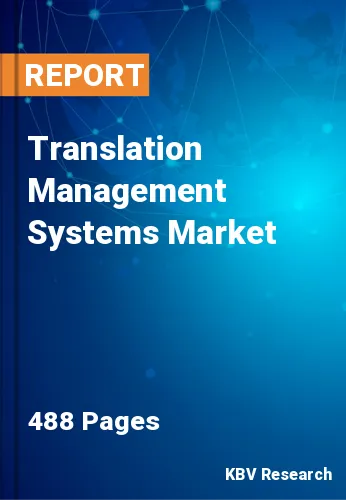
 Drivers
Drivers
 Restraints
Restraints
 Opportunities
Opportunities
 Challenges
Challenges
